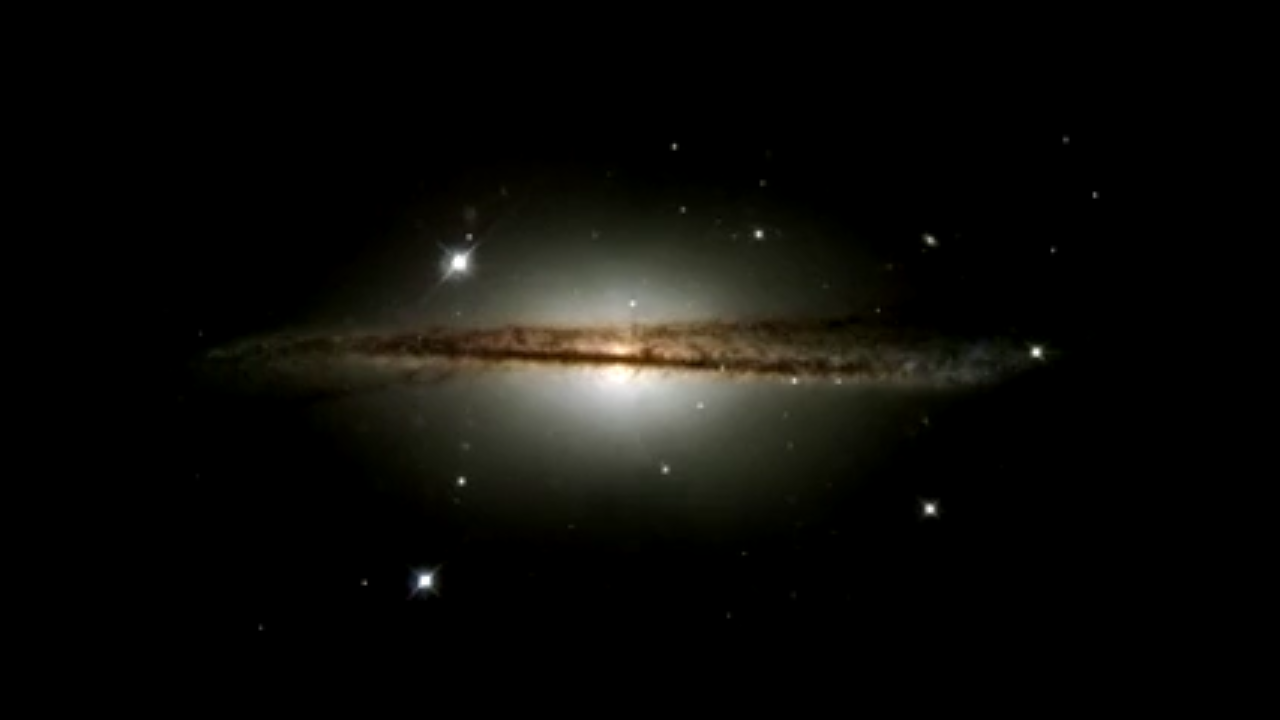1 min read
Warped Edge-On Galaxy ESO 510-G13

NASA's Hubble Space Telescope has captured an image of an unusual edge-on galaxy, revealing remarkable details of its warped dusty disk and showing how colliding galaxies spawn the formation of new generations of stars.
The dust and spiral arms of normal spiral galaxies, like our own Milky Way, appear flat when viewed edge-on. This month's Hubble Heritage image of ESO 510-G13 shows a galaxy that, by contrast, has an unusual twisted disk structure, first seen in ground-based photographs obtained at the European Southern Observatory (ESO) in Chile. ESO 510-G13 lies in the southern constellation Hydra, roughly 150 million light-years from Earth.
Details of the structure of ESO 510-G13 are visible because the interstellar dust clouds that trace its disk are silhouetted from behind by light from the galaxy's bright, smooth central bulge.
The strong warping of the disk indicates that ESO 510-G13 has recently undergone a collision with a nearby galaxy and is in the process of swallowing it. Gravitational forces distort the structures of the galaxies as their stars, gas, and dust merge together in a process that takes millions of years. Eventually the disturbances will die out, and ESO 510-G13 will become a normal-appearing single galaxy.
In the outer regions of ESO 510-G13, especially on the right-hand side of the image, we see that the twisted disk contains not only dark dust, but also bright clouds of blue stars. This shows that hot, young stars are being formed in the disk. Astronomers believe that the formation of new stars may be triggered by collisions between galaxies, as their interstellar clouds smash together and are compressed.
The Heritage Team used Hubble's Wide Field Planetary Camera 2 (WFPC2) to observe ESO 510-G13 in April 2001. Pictures obtained through blue, green, and red filters were combined to make this color-composite image, which emphasizes the contrast between the dusty spiral arms, the bright bulge, and the blue star-forming regions. During the observations of ESO 510-G13, WFPC2 passed the milestone of taking its 100,000th image since its installation in the telescope by shuttle astronauts in 1993.
About the Object
- R.A. PositionR.A. PositionRight ascension – analogous to longitude – is one component of an object's position.13h 55m 4.3s
- Dec. PositionDec. PositionDeclination – analogous to latitude – is one component of an object's position.-26° 46' 54.0"
- ConstellationConstellationOne of 88 recognized regions of the celestial sphere in which the object appears.Hydra
- DistanceDistanceThe physical distance from Earth to the astronomical object. Distances within our solar system are usually measured in Astronomical Units (AU). Distances between stars are usually measured in light-years. Interstellar distances can also be measured in parsecs.46 Mpc (150 million light-years)
- DimensionsDimensionsThe physical size of the object or the apparent angle it subtends on the sky.This image is 2.4 arcminutes wide, or roughly 32 kpc (105,000 light-years) at the distance of ESO 510-G13.
About the Data
- Data DescriptionData DescriptionProposal: A description of the observations, their scientific justification, and the links to the data available in the science archive.
Science Team: The astronomers who planned the observations and analyzed the data. "PI" refers to the Principal Investigator.Principal Astronomers: K. Noll, H. Bond, C. Christian, S. Crawshaw, L. Frattare, F. Hamilton, J. Lee, Z. Levay, T. Royle (Hubble Heritage Team/STScI) and C. Conselice (U. Wisconsin/STScI) - InstrumentInstrumentThe science instrument used to produce the data.HST>WFPC2
- Exposure DatesExposure DatesThe date(s) that the telescope made its observations and the total exposure time.April 6-7, 2001, Exposure Time: 3.3 hours
- FiltersFiltersThe camera filters that were used in the science observations.F450W (B), F555W (V), and F675W (R)
- Object NameObject NameA name or catalog number that astronomers use to identify an astronomical object.ESO 510-G13
- Object DescriptionObject DescriptionThe type of astronomical object.Edge-on Spiral Galaxy
- Release DateAugust 2, 2001
- Science ReleaseHubble Photographs Warped Galaxy as Camera Passes Milestone
- Credit
Share
Details
Claire Andreoli
NASA’s Goddard Space Flight Center
Greenbelt, Maryland
claire.andreoli@nasa.gov





























